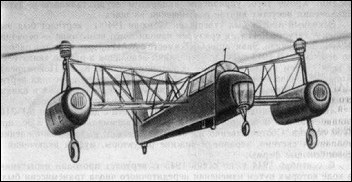
| Bratukhin "Omega" / 2MG 1947 |  |
 |

| Bratukhin "Omega" / 2MG 1947 |  |
 |
|
Also designated 2MG (twin-engined helicopter), this ambitious project was authorised on 27 June 1940 and launced Bratukhin as creator of a long series of machines with two engine rotor groups side-by-side. Steel-tube with fabric covering. Lateral structures carrying engine rotor units and fixed main landing gears were triangular spaceframes with two lower booms and one at top, with no covering. Fully articulated hubs of steel and light-alloy, carrying three duralumin blades, rotors being handed to rotate in opposite directions. Manual controls, driving swash-plates in fixed and rotating parts of head for collective and cyclic pitch control. Much research into optimum method with differential collective to apply initial bank and then T-tail rudder, worked by pedals, to make turns. Emergency control for immediately autorotative setting of both rotors, but single-engine flight intended by connecting shaft between engines with universal joint on aircraft centreline. Final 0.231 gearbox to rotors (577 rpm). No centrifugal clutches. Three mechanical clutches, with overrunning capability, engaged by observer after both engines were running. First drive to associated rotor was clutched-in; then interlink left/right shaft. Fuel tanks behind engines. Observer behind pilot. Helicopter ready for testing Aug 1941. Final design had no wheel or rotor brakes but trimming tailplane with pilot handwheel. Tentative hovering tests, interrupted by engine rough running and overheating. Six-month delay followed evacuation Oct 1941. Pilot K.I.Ponomaryov gradually made progress in 1942, discovering structural and control problems but remained tethered until early 1943. Engines seriously overheated. Omega II / G-2 Also sometimes called G-2 (helicopter 2), this was the original design with superior engines in streamlined pods with fan-assisted cooling. Drive ratio 0.32. Rotor masts and outriggers stiffened, and dymamic parts (cliutches and gearboxes) redesigned for long life. Test flown by Ponomaryov Sept 1944 with good results. Damaged Jan 1945, repaired and improved (drive ratio 0.283) and used again from July 1945, by this time for research and pilot training. With chief engineer D.T.Matsitskii as observer, gained height of 3km. Demonstrated in Tushino by M.K.Baikalov Aug 1946. Bill Gunston "The Osprey's Encyclopedia of Russian Aircraft", 2000
When the WWII started, all helicopter related jobs were concentrated in single OKB-3 headed by Ivan Pavlovich Bratukhin. The "Omega" helicopter was the first product of this bureau. It was two-rotor helicopter of transversal design. Each rotor was driven by separate MV-6 engine linked with synchronizing shaft. This shaft provided also opportunity to fly helicopter with any one of engines running. Unlike primitive powerplants of earlier helicopters, engines of "Omega" were equipped with specially designed gearboxes, clutch and other elements typical for modern helicopters. Fuselage had metal (wielded steel tubes) frame with fabric cover. Airplane type T-shaped tail was used for flight control together with main rotors (also fully instrumented). Project was approved on June 27,1940. Aircraft was finished in August 1941, and flight tests began (first - on the tie). Evacuation of the OKB-3 interrupted works on the "Omega" for 1 year. Only in 1943 flight tests started again (pilot K.I.Ponomarev). Tests included takeoffs, landings, 360° turns while hovering, straight flight and sharp turns. Also was tested (on purpose) ability of the helicopter to 'glide' safely with engines shot down, using effect of autorotation. Modifications:
|